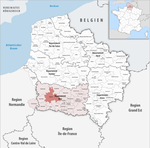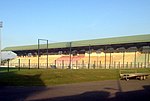Jeanne Hachette
15th-century French peoplePeople from BeauvaisWomen in 15th-century warfareWomen in medieval European warfareWomen in war in France ... and 2 more
Year of birth uncertainYear of death unknown

Jeanne Laisné, also known as Jeanne Fourquet in the 16th century and better known as Jeanne Hachette is an emblematic figure in the history of the French city of Beauvais' resistance to the siege laid by Charles the Bold, Duke of Burgundy. She is said to have helped to repel a Burgundian attack on the town of Beauvais with a hatchet and, in popular history, has been elevated to the rank of French heroine. She was born in Beauvais, around 1454, and died on an unknown date. The details of her life and even the fact of her existence, have been the subject of debate among historians, although several contemporaneous documents refer to her existence.
Excerpt from the Wikipedia article Jeanne Hachette (License: CC BY-SA 3.0, Authors, Images).Jeanne Hachette
Place Jeanne Hachette, Beauvais
Geographical coordinates (GPS) Address Phone number Website Nearby Places Show on map
Geographical coordinates (GPS)
| Latitude | Longitude |
|---|---|
| N 49.43 ° | E 2.0822222222222 ° |
Address
Brasserie Victor
Place Jeanne Hachette 15
60000 Beauvais
Hauts-de-France, France
Open on Google Maps









